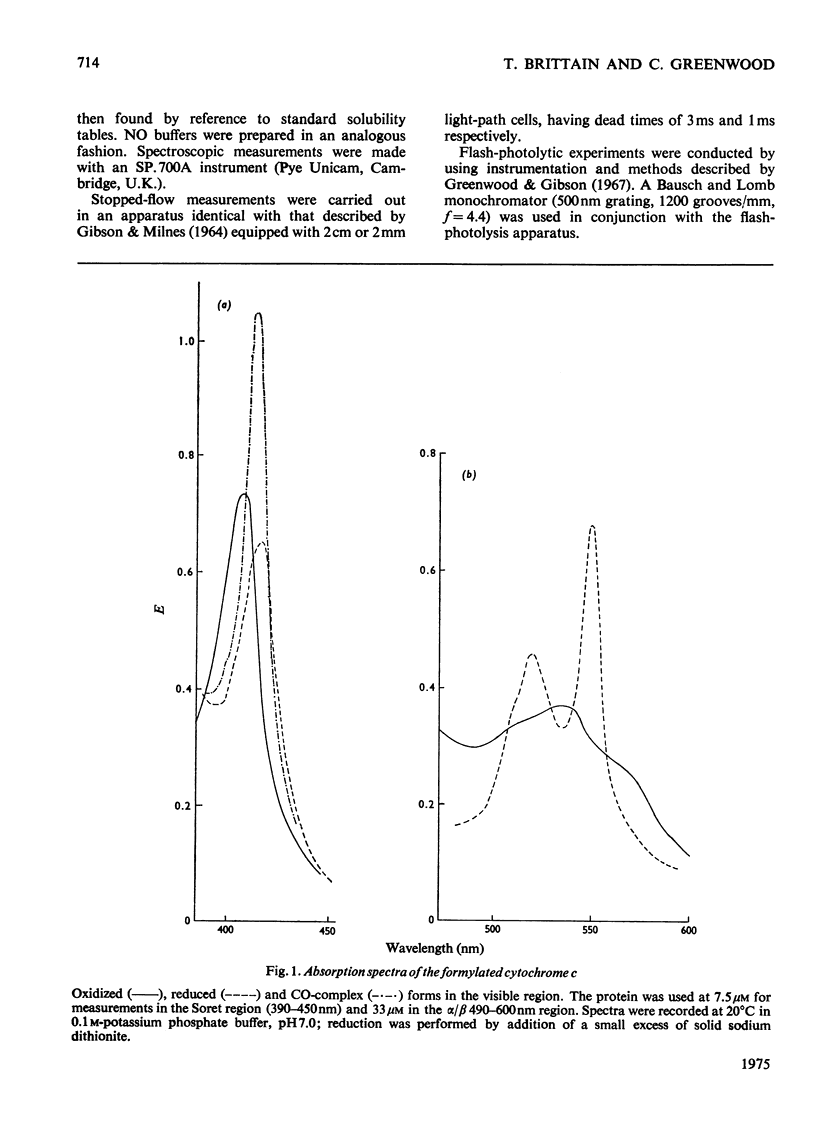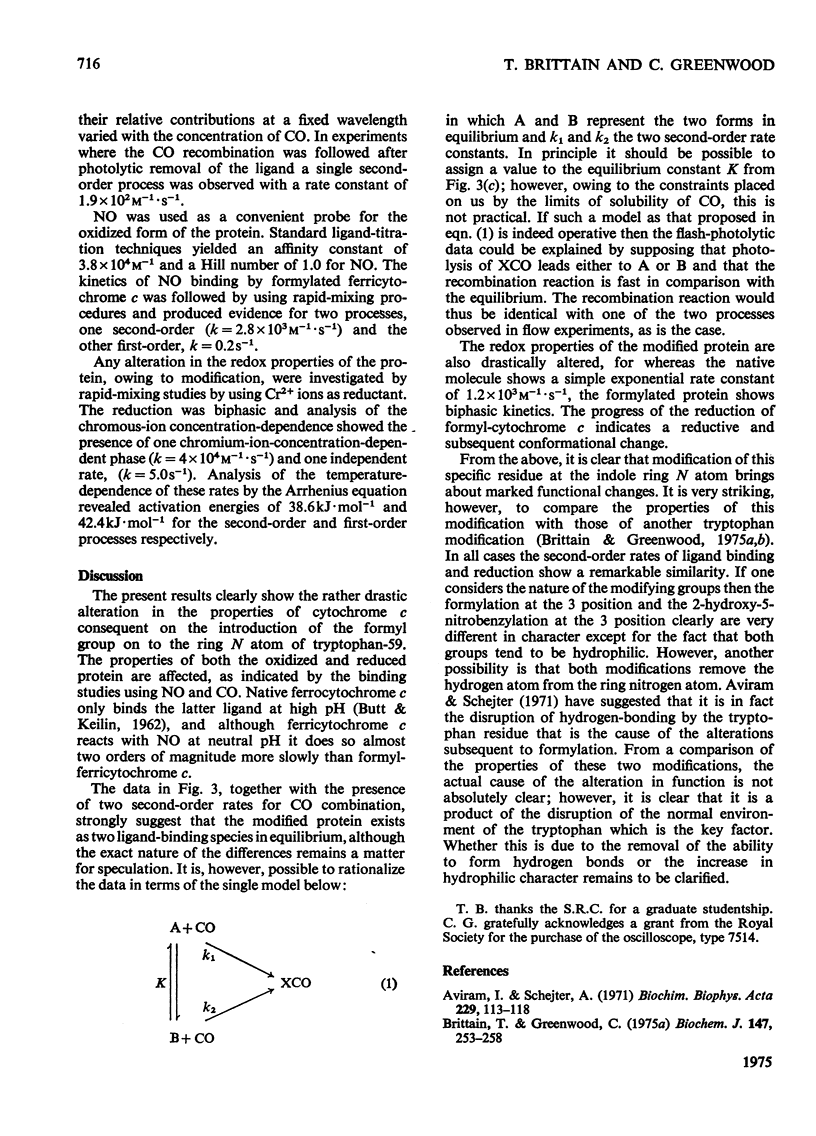Abstract
The formylation of the ring nitrogen atom of the tryptophan residue in cytochrome c was carried out and consequent changes in the kinetic properties of the protein were investigated. The reduction of formylated cytochrome c by Cr2+ was studied by stopped-flow techniques. At pH 6.5 the reduction process shows the presence of two phases. One phase (k = 4 X 10(4) M-1-s-1) is dependent on Cr2+ concentration and one phase (k = 5.0 s-1) is not. A study of the temperature dependence of the two phases yields values for their activation energies of 38.6kJ-mol-1 and 42.4kJ-mol-1 respectively. The reaction of the reduced formylated cytochrome c with CO was followed by means of both stopped-flow techniques and flash photolysis. The combination with CO at pH 6.8 measured in stopped-flow experiments shows two phases, both dependent on the concentration of CO (k1 = 1.8 X 10(2) M-1-s-1). If CO was dissociated from the protein by photolysis and then allowed to recombine with it, it was found to do so in a simple manner, at a rate which depended on the concentration of CO (k = 1.9 X 10(2) M-1-s-1). A tentative model which can accommodate these findings is proposed. The reaction of the oxidized form of formylated cytochrome c with NO was followed by means of stopped-flow techniques. The reaction was found to be biphasic with one phase dependent on the concentration of NO (k = 2.8 X 10(3) M-1-s-1) and one phase (k = 0.2x-1) independent of the concentration of NO. This behaviour is compared with that of the native molecule. A comparison of these kinetic observations with those on other tryptophan-specific modifications leads to the conclusion that the main alteration in kinetic properties is due, not to the nature of the modifying group, but rather to the disruption of the normal environment of the haem.
Full text
PDF




Selected References
These references are in PubMed. This may not be the complete list of references from this article.
- Aviram I., Schejter A. Modification of the tryptophanyl residue of horse heart cytochrome c. Biochim Biophys Acta. 1971 Jan 19;229(1):113–118. doi: 10.1016/0005-2795(71)90324-2. [DOI] [PubMed] [Google Scholar]
- BUTT W. D., KEILIN D. Absorption spectra and some other properties of cytochrome c and of its compounds with ligands. Proc R Soc Lond B Biol Sci. 1962 Nov 20;156:429–458. doi: 10.1098/rspb.1962.0049. [DOI] [PubMed] [Google Scholar]
- Brittain T., Greenwood C. Kinetic studies on mammalian cytochrome c modified with 2-hydroxy-5-hydroxy-5-nitrobenzyl bromide. Biochem J. 1975 Jul;149(1):179–185. doi: 10.1042/bj1490179. [DOI] [PMC free article] [PubMed] [Google Scholar]
- Brittain T., Greenwood C. The preparation and some properties of mammalian cytochrome c modified with 2-hydroxy-5-nitrobenzyl bromide. Biochem J. 1975 May;147(2):253–258. doi: 10.1042/bj1470253. [DOI] [PMC free article] [PubMed] [Google Scholar]
- Brittain T., Wilson M. T., Greenwood C. The reduction of carboxymethyl-cytochrome c by chromous ions. Biochem J. 1974 Aug;141(2):455–461. doi: 10.1042/bj1410455. [DOI] [PMC free article] [PubMed] [Google Scholar]
- Coletti-Previero M. A., Previero A., Zuckerkandl E. Separation of the proteolytic and esterasic activities of trypsin by reversible structural modifications. J Mol Biol. 1969 Feb 14;39(3):493–501. doi: 10.1016/0022-2836(69)90140-5. [DOI] [PubMed] [Google Scholar]
- Gibson Q. H., Milnes L. Apparatus for rapid and sensitive spectrophotometry. Biochem J. 1964 Apr;91(1):161–171. doi: 10.1042/bj0910161. [DOI] [PMC free article] [PubMed] [Google Scholar]
- Greenwood C., Gibson Q. H. The reaction of reduced cytochrome C oxidase with oxygen. J Biol Chem. 1967 Apr 25;242(8):1782–1787. [PubMed] [Google Scholar]
- Margoliash E., Schejter A. Cytochrome c. Adv Protein Chem. 1966;21:113–286. doi: 10.1016/s0065-3233(08)60128-x. [DOI] [PubMed] [Google Scholar]
- Myer Y. P. Structure and enzymatic properties of N-bromosuccinimide-modified horse heart cytochrome c + . Biochemistry. 1972 Nov 7;11(23):4195–4203. doi: 10.1021/bi00773a001. [DOI] [PubMed] [Google Scholar]
- O'Hern J. O., Pal P. K., Myer Y. P. Conformational and functional studies of chemically modified cytochromes: N-bromosuccinimide- and formyl-cytochromes c. Biochemistry. 1975 Jan 28;14(2):382–391. doi: 10.1021/bi00673a027. [DOI] [PubMed] [Google Scholar]
- Previero A., Coletti-Previero M. A., Cavadore J. C. A reversible chemical modification of the tryptophan residue. Biochim Biophys Acta. 1967 Dec 12;147(3):453–461. doi: 10.1016/0005-2795(67)90005-0. [DOI] [PubMed] [Google Scholar]
- Ransom F. A contribution to the study of muscle-enzymes. J Physiol. 1910 Apr 26;40(1-2):1–16. doi: 10.1113/jphysiol.1910.sp001360. [DOI] [PMC free article] [PubMed] [Google Scholar]
- Takano T., Kallai O. B., Swanson R., Dickerson R. E. The structure of ferrocytochrome c at 2.45 A resolution. J Biol Chem. 1973 Aug 10;248(15):5234–5255. [PubMed] [Google Scholar]


